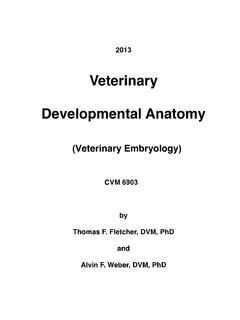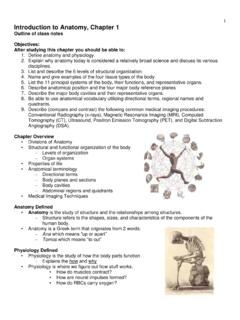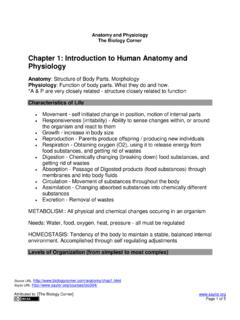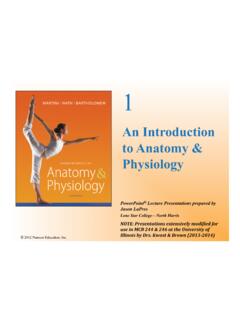Transcription of Human Anatomy - University of Utah
1 Human AnatomyLab ManualSixth EditionMark NielsenUniversity of UtahSummer TermiiiContentsOrientation ..1 Tips ..3 Labs ..5 Laboratory One ..9 Laboratory Two ..17 Laboratory Three ..23 Laboratory Four ..29 Laboratory Five ..35 Laboratory Six ..41 Laboratory Seven ..51 Laboratory Eight ..57 Laboratory Nine ..63 Laboratory Ten ..69 Practical Tips ..75 Human Anatomy Lab ManualivPrefaceThis book is for students in Biology 2325 - Human Anatomy . As you begin your anatomical learning adventure, use this book to prepare for the laboratory. It is designed to help you prepare for and get the most out of each of the laboratory sessions. There is a chapter for each of the labs that has a list of objectives that you should use to prepare for lab. If you follow these objectives you will arrive at lab prepared and you will maximize your learning efforts. All the material you will cover in each laboratory along with what you will need to do to prepare for the lab quizzes each week is covered in this to the Human Anatomy laboratory that accompanies the lecture in Biology 2325 - Human Anatomy .
2 This lab provides you with a rare opportu-nity to explore Anatomy using dissected Human cadavers. Exploring cadavers is the true approach to learning Anatomy , that is, experiencing Anatomy in its three-dimensional reality. There is no better way to learn this subject. In lecture you will use your sense of hearing to listen and learn and your visual sense to see two-dimensional illustrations throughout the lecture. The lab opens the door to additional senses those of touch, three-dimensional vision, and even the unique smell of a cadaver lab. This allows you to gain a total exposure to the design of the Human may have asked yourself as you were registering for this class, what can I expect in the Anatomy lab? How do I prepare for lab? What is expected of me? The following information will help answer these questions and provide guidelines for a successful learning Each lab will begin with a visual quiz that will require approximately 10 minutes to administer.
3 There will be a total of eleven quizzes during the semester. All will count towards your grade. The quizzes are administered at the beginning of lab, so be on time. Questions will not be repeated for latecomers. You must attend the lab for which you are registered. Only under extenuating circumstances, and with Professor s written approval, can you take a quiz in another lab, or for that matter attend another lab The quizzes are visual tests that you will take at the beginning of the lab session. The quiz will cover the material that you will study in the lab. The purpose behind quizzing students on material they will be studying in the current lab is to encourage students to come to lab prepared. Years of expe-rience, have demonstrated that this helps students get the most out of their lab experience. The Human Anatomy Interactive Atlas, a web-based software that accompanies your books contains numerous cadaver photographs that you will study in preparation for the lab quizzes.
4 These cadaver photo-graphs correspond to lecture material from the previous week and are similar to the cadaver materials you will study in the lab. Each photograph is a professionally prepared dissection to not only help you prepare for the lab, but also to allow you to take the lab home with you. By having access to these excellent photographs, you can study the cadavers from the lab without being in the lab. 3. Attendance is required as the lab is 30% of the course grade. The lab time should be used wisely. Again, history demonstrates that the students who perform best in the course are those who come prepared for lab, work hard, and do not waste time in the Anatomy Lab Manual24. There can be no food or drinks in the A seating chart will be assigned, so pick the seat you want for the semester. This helps the teaching staff learn your names and allows them to run a more orderly Never touch skeletal material or models with pens and pencils as it mars these expensive, hard-to-replace materials.
5 Use a probe to point to these objects. Handle all skeletal material with extreme care, as this will help us prolong the use of these unique and valuable teaching Guests and visitors are not allowed in the lab. There is simply not enough room for people who are not registered for the course to attend the Anatomical materials cannot be loaned out to students. The materials used in the lab are to remain within the lab. There are no It is a privilege to have Human body parts to study and use as learning aids. Very few undergraduate courses have access to Human body parts. Please respect this Following the quiz there will be a brief orientation by the teaching assistant in charge of the lab. This will be followed by the general lab Students are responsible for identifying the structures listed on the designated pages of this manual for quiz and test purposes. During the lab you will work with teaching assistants who will teach you using the prosected cadavers.
6 They will help you identify the structures listed in the lab manual and will teach you techniques to learn Anatomy on the cadaver prosections. 12. Students should prepare for lab by reading the objectives for the pertinent lab each week. This is extremely important. If you are prepared, you will maximize your learning It is important to use the lab time wisely. During the majority of the lab period you will be involved in small, structured learning groups. In these small groups a teaching assistant will work with you to help you see and learn the Anatomy on the cadavers. There will be other periods of time during some of the labs where you will have time to review what you are learning by taking practice practical The lab contains a variety of materials to help you visualize the Anatomy being covered in the lectures. There are pictures, models, and Human body parts. Be aware of all these materials and use them to your full advantage in learning Take advantage of the staff of teaching assistants in the labs.
7 Do not hesi-tate to ask questions. The only bad questions are those that are not asked! Every effort will be made to answer even the most difficult of The Anatomy staff encourages you to fully participate and take complete advantage of the materials and resources available. With proper prepa-ration this lab can be an exciting and unique educational experience. HAVE FUN AND GOOD LUCK!3 TipsThe following techniques will be useful in learning anatomical concepts throughout this course. Before each lab, review this list and apply the appro-priate concepts to the lecture Hands on!!: Exploration and touching of cadaver parts is essential. The more you handle and examine cadaver parts the more familiar you will become with orienting, recognizing, and discovering specific anatomical Palpation: This is the process of exploring structures with your hands on your own or someone else s body. Realize that your own body is a Human Anatomy review sheet ( Anatomy can be fun with a partner, too).
8 Palpation can be used to study bony landmarks, muscles, tendons, ligaments, ves-sels, and nervous structures. Whenever you are learning a new anatomical structure, try and palpate it on your own Etymology: Many anatomical terms are derived from Latin and Greek roots. Often terms that look foreign to you are actually very descriptive. The term might describe the size, shape, action, or location of the anatomi-cal structure being named. By dissecting a term s Latin or Greek origin you can make memory associations that help with learning the anatomical structures. For examples of this approach, look at the chapters Anatomical Nomenclature and Anatomical Etymology in the Human Anatomy Lecture Traces: A trace is a sequential path of chambers, vessels, tubular structures, valves, or nervous structures through which a substance or impulse passes as it travels from one region of the body to another. When learning sys-tems, such as the cardiovascular, respiratory, digestive, urinary , or nervous systems, traces provide an excellent technique for identifying the structures in an ordered fashion.
9 This is an excellent way to see if you understand the big picture. Learning a trace through a system will help you reinforce the sequential relationship between the structures of that system . Remember you can trace molecules from one system to another across diffusion or transport barriers, such as an oxygen molecule from the alveolar air spaces in the lungs to the pulmonary capillaries that surround those air spaces!5. Form and function: Often anatomical structures are not only named for their shape or size, but for functional characteristics as well. The reverse can also be true, the function or structure can be logically deduced from the anatomical name ( ; Name: Pronator teres; Function: round muscle which pronates). Human Anatomy Lab Manual46. Topography: The Human body is like a map. Once you recognize a par-ticular structure, it can then be used to identify other structures in the same area. As you learn the topographical relationships between muscles, organs, bones, nerves, and vessels, you can begin to make associations with known key structures.
10 Understanding how structures are related to easily identifiable, obvious structures, makes identifying the various parts of the body an easier Logic and simplification: Look for common themes, such as, compart-ments, innervation, action, location, tissue type, etc. Think logically! Learn structures according to common groups and characteristics. This is always superior to shear Mnemonics: Mnemonics can be a useful memory device. They are most useful in learning structures that can be grouped or categorized ( , the rotator cuff muscles the Supraspinatus, Infraspinatus, Teres minor, and Subscapularis are the SITS muscle group).There is a wealth of material that you can use as a reference to help you prepare for the laboratory, as well as study for the course. These materials are visually stimulating and will, if used, enhance your lab preparation, along with your ability to learn Anatomy . Anatomy is a visual subject, therefore one of the most effective ways to learn and understand it is to do as much visualization as possible.






